|
News and Events
Garden Route, South Africa
April 9, 2006 Knysna, South Africa
Today we drove about 90 min to Knysna
(pronounced “neesna” or “n-eye-z-na;” it’s one of those two. I was never able to nail it down. The
accents here are pretty thick). We spent two days at the Protea Hotel, which were very uneventful. The
only thing we did was hang out at the pool and pay $18 per hour for internet access. They seemed to nickel
and dime us to death here.
April 10, 2006
April 11, 2006 Plettenberg Bay
Today we drove about 30 min to Plettenberg Bay and stayed at Coral Tree Cottages. A great place with kitchen and two rooms. Brilliant.
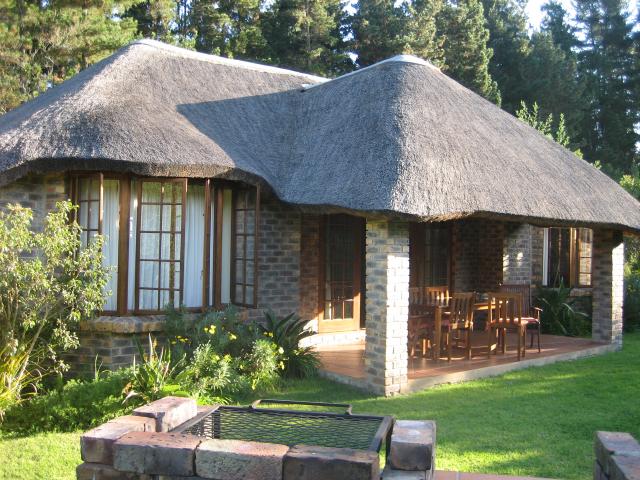
April 12, 2006
Monkey Land
We visited Monkey Land (server may be
down...) today. Monkey Land is a private reserve that houses all types of primates in a 57 acre
fenced area that the visitors can walk through.
But I must confess, I did not know that Monkey Land was about 57 acres in size. I went
to their website and I saw that it was 23 hectares in size. I then did a Google search for
“hectare to acre conversion” and Google came back with “1 hectare = 2.47105381 acres.” Did
anyone else know that Google has a built in calculator and conversion engine built into their
search engine?!! How cool is that. You can do any of the following calculations or conversions:
- 100 usd to South African rand (100 U.S. dollars = 611.168493 South African rand)
- 25 liters to gallons (25 liters = 6.60430128 US gallons)
- 25 celsius to Fahrenheit (25 degrees Celsius = 77 degrees Fahrenheit)
While this feature is incredibly cool, there is a downside:
- you need Internet access in order to use it (a challenge for us, at best)
- they haven’t incorporated all of the convertible measurements.
For instance, I also typed in the following:
- 1 Indian ground to square meters (an informal unit of land area in India, especially southern
India, equal to roughly 200-220 square meters).
- 1 gill to pints (1 gill, pronounced “jill,” is roughly equivalent to .25 pints).
- 1 mole hydrogen to grams (1 mole H2 = 2.016 grams).
So, in order to combat these inaccuracies, I’ve downloaded a freeware program called convert from JoshMadison.com. It’s brilliant.
April 13, 2006
Today we saw rhinos and I cooked ostrich meat. Very manly day, it was.
We drove about 30 min from our cottage to the Rhino Base Camp, a private game reserve that specializes in
two hour game treks. This is the lazy man’s version of a safari. We knew that we would be guaranteed to see t
he big animals, and we were not ashamed of this. When you come to Africa, you have to see elephants and rhinos,
right? It’s the same when you visit North Carolina, USA—you need to see some bluegrass and some rusted cars
up on blocks in the front of people’s yards.
When we arrived at the Rhino Base Camp we were met by a young person that was dressed in
the typical safari outfit—khaki shorts, the safari shirt with the useless epaulets
(what are these for?...), and the cool safari hat with the obligatory boots with non-white
socks. Man, I was wishing for my new safari vest that I left back at the cottage….
He led us through a HUGE banquet hall that was filled with stuffed animal heads,
skulls and hides. If you look at it from an animal lover’s perspective, you’re in hell;
if you look at it from any other perspective, you feel as though you just stepped into a
Stephen Spielberg film.
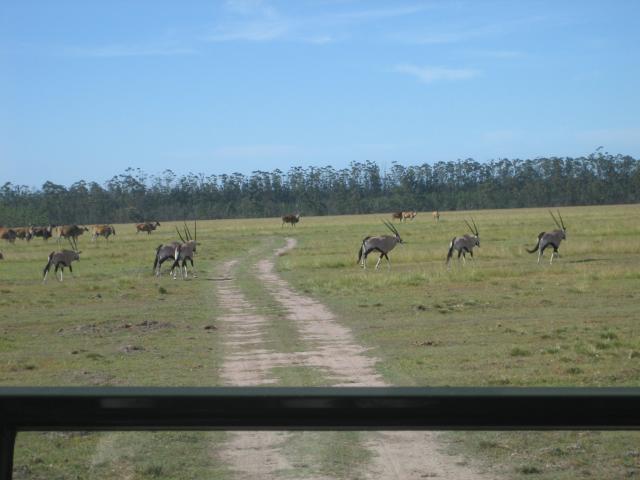
The actual game drive was a bit of a letdown because the place is a private reserve. Limited space,
which means that it’s easy to find the animals, and that’s a bit of a letdown if you think you’re on a
safari drive. It was too easy to see the animals, even if we saw them very closely.
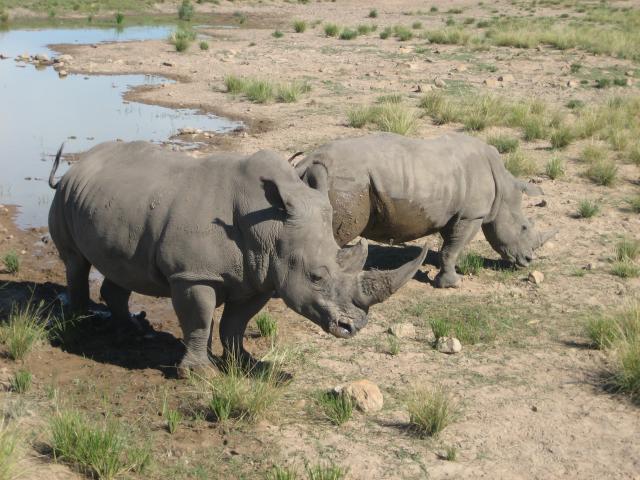
One of the cooler things at this camp was the vehicle that we used to get out on the
reserve. It's called a Unimog. Engine made by Mercedes;
body made by whoever makes really tough-looking, very manly vehicles. It felt
very African-safari-like.
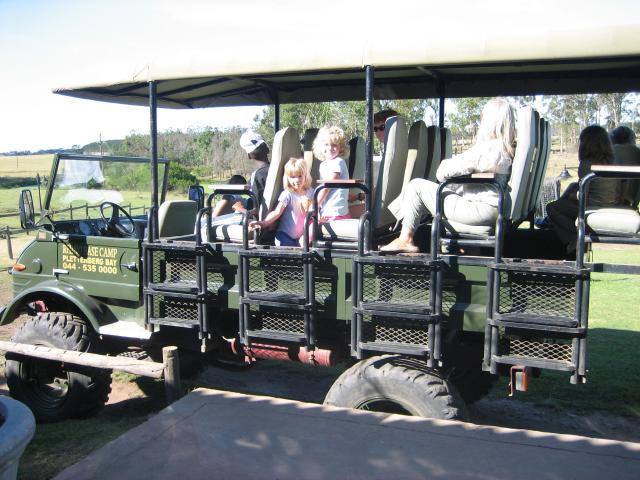
Braaing—The Ostrich Meat Incident
A Braai (pronounced br-eye) is the South African version of a barbecue. Like barbecue, the word 'braai'
is a noun and a verb. As a noun, it refers to the grill itself and as a verb you would 'braai some steak'.
Braai also refers to an event, so in the same way you would host a barbecue, you would also host a braai.
The only difference is that where you would generally only hold a barbecue during summer months, the
Southern hemisphere climate means you can braii during winter.
Today I braaied some ostrich. It’s very common to use wood to do your braaing—burn your wood,
get it down to red coals, then cook your meat over it. It’s a longer process than we’re used to
with lump charcoal, but I like the smoky flavor. The wood here was acacia, which is very dense
and imparts a wonderful sweet flavor. Similar to oak, but better flavor. And the wood here is
very dry so starting it is very easy. Now I don’t usually like to brag about my braai, but I
think it turned out quite nicely.
April 14, 2006
Today is Good Friday. Everything in South Africa closes on Good Friday. Chalk this day up
to poor planning because we had barely enough food/drinks for this day. And it was raining
in the afternoon, so we didn’t do much today. Except curse our poor planning. But it dawns
on me that we haven’t acknowledged the elephants in the room, namely Apartheid and AIDS in
South Africa. Many of the people, especially the US Department of State, respond with shock
and awe when we say we’re going to visit South Africa. The idea of touring South Africa is
akin to touring war-ravaged Iraq-- You need to hire an armed guard, wear condoms all the time,
get shots for any and all airborne diseases, and watch your pockets for thieves.
Every country/city/state has its bad areas and you need to avoid those. But the country of
South Africa is incredibly beautiful; the people are extremely friendly; the atmosphere is one
of safety. For the most part, people here are well-educated, well-fed, and very healthy. Yes,
as in every country there are places that even the locals won’t want to visit/drive. But these
are few and far between, as in the states, and the poverty rates drive the crime as in every
country in the world.
During most of the 20th century, South Africa was ruled by a system called Apartheid, which
was based on the segregation of races. The term comes from an Afrikaans word meaning 'apartness'.
The term Apartheid was introduced during the 1948 election campaign. The United Party
actually gained the majority of votes in the 1948 general election. But due to the manipulation
of the geographical boundaries of the country's constituencies before the election, the
Herenigde Nasionale Party (HNP) managed to win the majority of constituencies and took
power. In 1951 the HNP and Afrikaner Party officially merged to form the National Party,
which became synonymous with Apartheid.
Over the decades, various forms of legislation were introduced which extended the
existing segregation against Blacks to Coloreds and Indians (these are three separately
recognized racial groups in South Africa. Blacks have very dark skin; Coloreds have the
lighter brown skin, like Halle Berry; Indians are descended from South India). The most
significant acts were the Natives Act of 1952 (Abolition of Passes and Co-ordination
of Documents) which, despite its title, led to the rigid application of Pass Laws.
During the 1960s, racial discrimination applied to most aspects of life in South
Africa and Bantustans (territories designated by the government as tribal homelands
created for the blacks in South Africa). The system had evolved into 'Grand Apartheid'.
In February 1990 President FW de Klerk announced Nelson Mandela's release and
began the slow dismantling of the Apartheid system. In 1992 a whites-only referendum
approved the reform process. In 1994 the first democratic elections were held in South
Africa, with people of all races being able to vote. A Government of National Unity was
formed, with Nelson Mandela as president.
Regarding AIDS, it’s rampant here because of the poverty and the extremely high
unemployment, currently around 30%. A mother would rather sleep with someone for
food for her children and risk contracting Aids than let her children go hungry.
The delta between the extremely rich and the extremely poor is huge. And the Townships are everywhere.
One of the things that we’ve really wanted to do but haven’t been able to schedule
is to take a tour of one of the townships. Townships are underdeveloped residential
communities created by the influx of people post-apartheid to a new democratic South
Africa. During Apartheid, these communities were reserved for non-whites only.
During the Apartheid Era Non-whites were usually evicted from properties that
were in areas designated as "white only" and forced to move into townships.
There are two different types of townships—government created, and self-created.
The government created townships are hundreds/thousands of cinderblock-built
houses that look to me to be about 10’ x 20’ in size, certainly no larger than
that. They have electricity and many have indoor plumbing. They look to be clean,
the dirt streets well-kept, and there may be thousands of them in blocks/rows to a single township.
The self-built townships are hastily created shacks that are built from spare
parts. Corrugated metal roofs or plywood are held down with tires or cinder blocks,
tarps for walls, certainly no indoor plumbing. BUT, they do have electricity and they
are recognized by the South African government as legitimate housing. Go figure.
These are usually built on private property owned by local African chiefs.
Although formal racial segregation ended with Apartheid in 1994, new township-like
areas for low-income persons were, and continue to be, developed
Township Video
Note: if you can not see the video, download QuickTime and view the movie with it.

April 15, 2006
We went to the local market this morning. Not knowing what to expect, we kept an
open mind and a hopeful heart. The market was very small with some local artisans and
some local food. It was pretty uneventful and pretty short. We were left with trying
to figure out what to do with the rest of the morning.
Good thing we have pickup sticks and Parchesi…
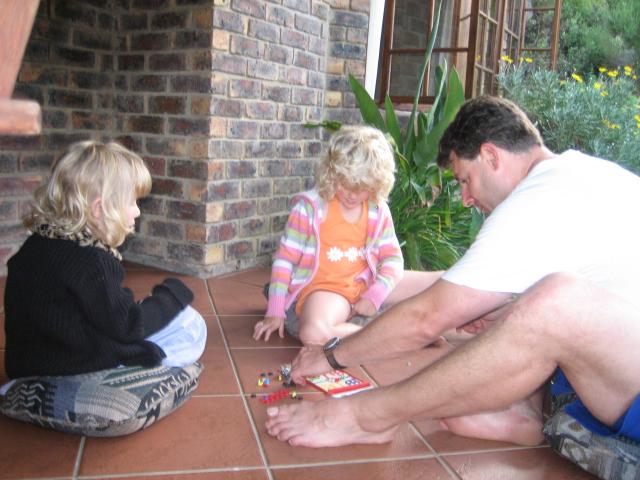
April 16, 2006
Today was an all-day Easter celebration at a local polo club. I highly recommend
polo as a sport to watch. Great fun. Like soccer or hockey, but on horses. The animal
factor is always fun in a sporting match. A buddy of mine said his cousin got a
scholarship to a school that plays lacrosse on horses. I don’t know what that’s
called, but it seems to me that there’s a trend of taking a legitimate sport and
someone says, “Hey, let’s play this game, only let’s do it on horses/camels/elephants.
”It’s only time until someone says, “OK, water polo on horses.” We can be so silly at times.
The Easter celebration was great. The gates opened at 11am and the festivities
started promptly at 11:30. First was authentic African singing and dance. Both were
great, but a little jaded by the fact that two of the women singers held brand new
mobile phones during their singing (one actually received a call during the singing),
and 3 of the dancers had logo t-shirts on advertising “Billabong,” and, “Vodacom.” This
took a little bit of wind out of the sails of the “authentic” African song/dance, but it was great to experience anyway.
Skydivers were next and each of the five divers dropped a bag of goodies onto the
polo pitch. Sorry to get all polo-technical on you. The field is called a “pitch;”
the match is broken into six “Chuckers,” each one being 8 minutes long.
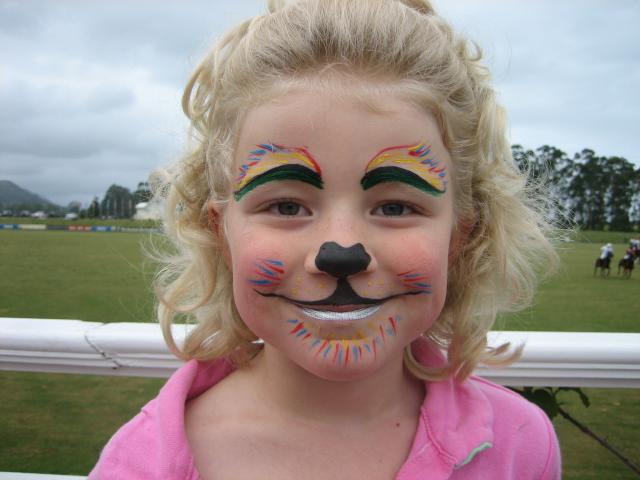
After all the kids ran onto the field to scavenge for the goodies, then the organized fun
started. Egg-on-spoon races, then three-legged races, then apparently a non-scheduled event,
the “male of the human species race to the bar to stock up on beer” race. Yeah, South African
men aren’t too dissimilar from North American men…
Easter Egg Hunt Video
One of the weird things about polo is that they change sides of the field after each goal.
So you, as the spectator, are pretty clueless as to which team is headed for which goal. This
is actually a good thing because, in your beer-induced stupor, you have no idea who you’re
rooting for because the pitch is the size of Rhode Island. And I swear they change numbers
several times during each chucker. We need Fox Sports to come here and put that little computer
chip into the ball so we can see where the heck that thing is.
April 17, 2006
Driving day. Four hours to the Addo Elephant National Park. We stayed in a forest
cabin, which is exactly what it sounds like. Very small (marketing people call it,
“cozy”), four separate twin beds (marketing people call it, “separate sleeping
arrangements”), and apparently self-catering here means, “we have 4 cook tops and
two sinks that are shared among 10 cabins.” So things here were more rustic than
we’ve been used to, but it was great fun.
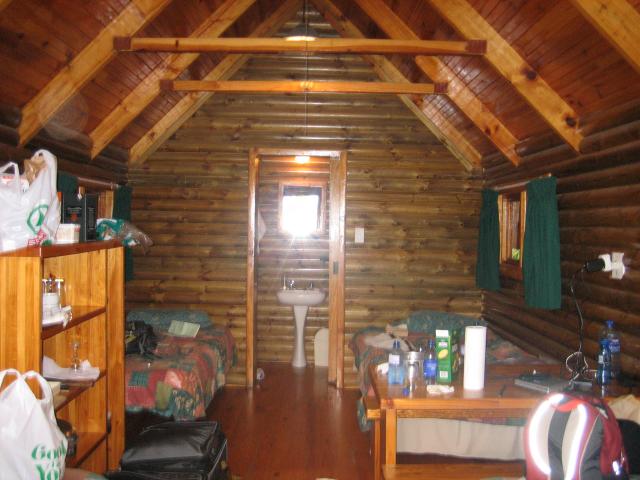
It rained all day which is good for a travel day. But we arrived at the park
around the 1pm check-in time and we could enter the park for a self-guided tour.
This means that we can take our own car and enter the “wild” of their 170,000
hectares of land to interact with the animals. This was a novel and exciting idea
for us, despite the continued rain. We know the following animals are somewhere
in this park and we’re excited to see them all:
Lions
Elephants (ie. You DO have elephants in your Elephant Park, right?...)
Black Rhinos
All types of antelopes (kudu, eland, springbok, and wildebeest)
Water buffalo
Zebras
Wart hogs
Meerkats
So we were very excited to see all of these animals. And it was raining. And we saw some wart
hogs and some ostriches and one of the types of antelope.
Then we got stuck in the mud.
We're Stuck in the mud Video
Most of the park roads are paved; some are not. The main rule in the park
is DO NOT GET OUT OF YOUR CAR. This is hammered at every turn/intersection.
You sign a document stating that if you get out of you car at approved water areas, you do so at your own risk.
We happened on one of the unpaved roads during the drizzle and barely made
it up the hill because of the mud. Then we got stuck along with six other cars.
Very Jurassic Park, eh? As we’re looking at the terrain and all the men are
pretending to know what to do (one dude even popped his hood and began fiddling
with his engine to “fine tune” it to mud driving), I couldn’t get the movie out
of my head. I figured that rampaging elephants or a pack of hyenas would spring
out of the bush and attack us at any given moment. So I kept hanging around two
of the older men there because I figured that I’m faster then they are. Remember,
you don’t need to be faster than the hyena—you just need to be faster than the hyenas’ prey. It’s the old joke:
Hiker 1: Oh uh. There’s a bear ahead and he’s running towards us. I’m outta here.
Hiker 2: (Bends down to take off his hiking boots and puts on his running shoes.)
Hiker 1: What are you doing? Bears are really fast. You can’t outrun a bear!
Hiker 2: I don’t need to outrun the bear; I just need to outrun you.
So during our one hour wait for the park rangers to pull us out of the mud,
I hung around the older, frailer looking men. Never let it be said that I do not want to propagate the Rousseau genes.
We didn’t see any elephants today.
April 18, 2006
The Addo Park has an interesting history. In 1919 a famous big game hunter
Major Jan Pretorius was asked to exterminate all the elephants that often
emerged from the Addo bushveld to demolish the crops of local farmers. In the
space of one year he shot 120 elephants until only 15 remained. In the face of
a national and international outcry, the hunt was called off and later the elephants'
survival was assured when the area was proclaimed a National Park in 1931. The numbers
of elephant have gradually grown over the years to well over 450 now.
We found out that children less than 6 years old are not allowed on the guided
tours the park offers. Hmmm… Would have been nice to know that up front, but we had
an out. We could hire a private tour guide that would travel with us in our car.
Perfect. And his name was Fabian.
The first thing Fabian does is point out dung beetles. I knew that these guys
were critical to the ecology, especially one in which each elephant excretes 100
kgs (that’s 220 lbs to you and me) of dung a day, but these little critters are
really interesting. Not only do they feed off of dung, but they use dung to house
their eggs. Poop is their life. They take the poop, roll it into a perfect ball,
pop their eggs inside and bury it, and out pops more baby beetles. PLUS, the dung
contains undigested food and seeds (an elephant only digests about 40% of its food),
so in burying the dung, the beetle also spreads seeds, natural fertilizer, and
undigested food into the soil. They are Nature’s little recycler. AND they’re a
protected species within the park—they have the right of way on the roads.
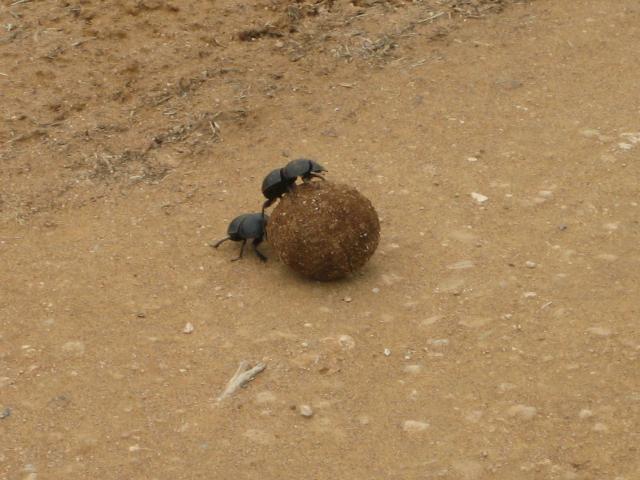
So Fabian was great in giving us the poop about all the animals we saw (sorry,
I couldn’t resist). Then we saw our first elephant. A lone bull (ie. Male) about
100 yards away, walking directly towards us down an access road. Very cool site.
Then he turns left and we head in his direction because the guide knows that there
is another access road about 50 yards down the road. Sure enough, the elephant comes
out of the brush and turns and starts walking towards us again. This keeps
happening until the pachyderm is about 30 yards away and then he hides in the
bush. But the hunt was excellent and the view was great.
Wart hogs: the bumps on the side of their faces are actually warts.
They are not bony protrusions. A male has four bumps; a female has two. When
they run their tail goes straight up in the air. This is to show other wart
hogs where they are in the tall brush so they can stay together.
Males of the antelope family have horns; females do not except the Springbok.
The Kudu’s horns grow a new curl every other year, so you can tell their age by
the number of curls in their horns.
African and water buffalo are the only true buffaloes on the planet. Our North
American Bison are not related to them, despite Americans constantly calling them
buffalo. African buffalo (used to be called Cape Buffalo but were recently renamed)
are also one of the most dangerous animals in Africa because they do not
advertise their attacks. Most animals will show some sort of aggressive
behaviour before attacking—elephants will toss their heads and splay their
ears; rhinos will paw the ground and give a couple fake charges; Hillary
Clinton will pretend to like you then say very bad things about you in front
of Congress. The buffalo will just ignore you until you feel yourself impaled
upon their curved horns, or trampled underneath their sharp hooves.
I loved talking with Fabian. I found myself falling prey to what I call, “Tour
Guide Einsteinism.” I will explain.
By their very nature, tour guides hold great knowledge of their subject. This
spills over to other subjects when people ask questions, so the respect of a good
tour guide raises the more he/she imparts knowledge. It doesn’t matter what kind
of tour guide it is—whether it’s a guide at the Elephant National Park or the Kango
Caves, a tour guide exudes confidence and knowledge. So I always feel like testing
their knowledge—do they really know everything, or is it just deep knowledge of the
subject at hand? I want to ask them questions like:
- I need to diversify my 401(k) investments, yet want to focus on environmentally
safe technologies. What are your opinions?
- Do I really need to change my oil every 3,000 miles, or is this just an
oil-company based limit to maximize consumer demand for oil?
- Why are manhole covers round?
Let’s see how smart they really are…
He actually did lead us to two elephant sightings, both very impressive and exciting.
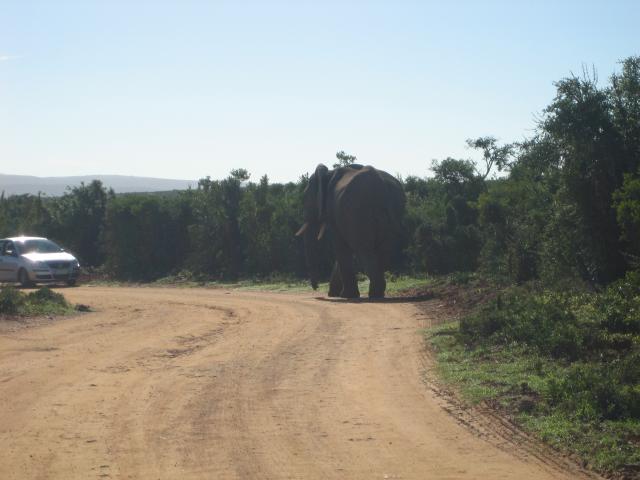
The first was a lone bull that was walking down a service road. We captured it on video here.
It was great fun because it was a big bull, it was walking towards us,
and we could follow its path through the road and bushes.
April 19, 2006
Our two night stay inside the Addo Elephant National park ended today and
we moved to Happy Lands B&B. This is a citrus farm
owned by Mike and Nita, native South Africans. It’s a really interesting place to
stay because they’ve turned their land into a beautiful English garden that’s situated
in the middle of citrus trees everywhere. We awoke to the smell of freshly
roasted coffee, made from raw coffee beans that Mike roasts in his popcorn popper
every morning. He plans to take his coffee-making to the next level by planting
some coffee bushes and harvesting his own beans. Mike and Nita really made us feel at home.
We also did another self-drive through the park and we put our newfound tracking
skills to work. We rounded a corner and not 15 feet in front of us was a huge male
elephant on the road out for a morning stroll.
Elephant on the Road Video
April 20, 2006
Today was an errand day. We needed to put our attention to the more
mundane things of living and travel, like haircuts and clothes washing.
As we ate lunch at a restaurant, I again was surprised by the lack of napkins
on the table. I don’t know if I need more napkins than normal human beings, or
that our demand for napkins is driven by our children, or that we, as Americans,
are just more sloppy eaters than Thai people or South Africans. Regardless, I need my napkins!
April 21, 2006
Since we’re now experts at finding elephants in the Elephant National Park,
we decided to do cheetahs and lions today. We visited Daniel’s Cheetah Breeding
Park and the Addo Lion and Crocodile Reserve.
As Americans we are used to signing 3 pages of documents signing away
our rights of liability. We are used to helmets, 15 minutes of safety training,
signs warning us from dangers, rangers spouting their safety warnings, and fences
alerting us from our own stupidity. But what’s funny about this is that South
Africa does not have any of these helmets nor 'legalese' in their documents. They
all have a posted sign that’s quite easy to read that says, “Enter at your own
risk. We will not be held responsible for any damage.”
Amazing. apparently, it works quite well for them. We should learn this lesson.
So at Daniel’s Cheetah Breeding Park, which we entered without signing any
liability waivers, the girls got to feed a kudu that was rescued, and we got
to pet a cheetah. That’s really all there is to do at this park. Kudu-feeding
and cheetah-petting is very cool though. So the high coolness factor made up for
the lack of anything else to do factor.
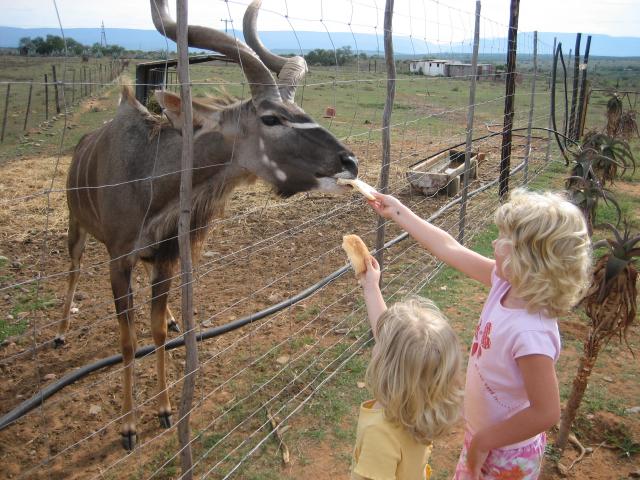
Feeding the Kudu Video
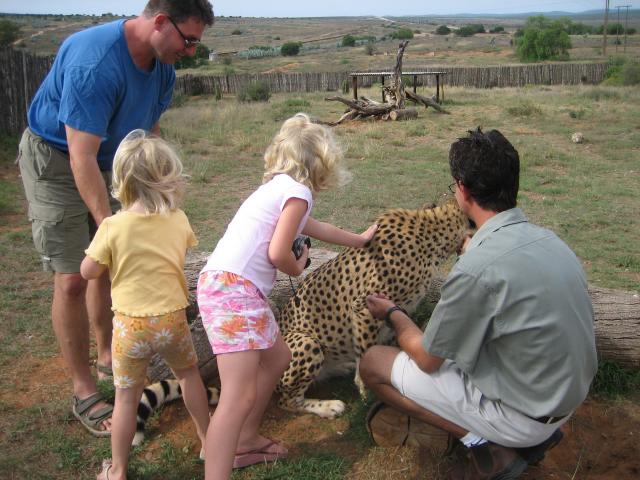
Petting a Cheetah Video
Then we visited the Addo Lion and Crocodile Reserve. This was like a tiny
zoo that contained crocodiles, lions, tigers, wild boar, and some monkeys. It
doesn’t sound like much, but they had about four dozen lions from newborns to
adults, and we could go all the way up to the fence and touch them. It was
very surreal because the adult cats were stalking Annette and Dominique.
Wherever the kids went, the cats followed because they wanted a small, easy-to-kill snack.
Stalking Lion Video
April 22, 2006
Today we went to the Port Elizabeth Oceanarium. Oceanarium = fancy name for
aquarium. We saw a dolphin show. When was the last time you saw a dolphin show?!
It wasn’t as polished as some of the other dolphin shows that I’ve seen at places
like SeaWorld, but it was quite fun anyway. It left me thinking about how difficult
it must be for the animal trainers to get the fish smell off their hands after work.
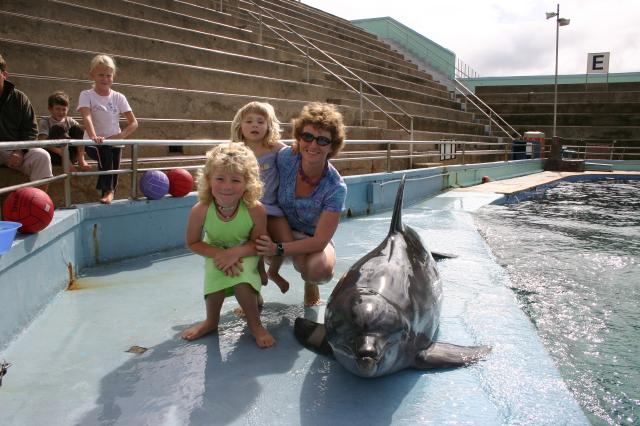
April 23, 2006
Fly from Port Elizabeth to Johannesburg. Drive about 1.5 hrs. to Lesedi
Cultural Village. The fight time was changed/delayed by 4.5 hrs. so we didn’t
arrive at Lesedi until a little after 8:30pm. We missed dinner and the cultural
show, but were able to get some sandwiches and we crashed very quickly.
Odd and Ends
- Nicky has been home schooling Dominique and she’s learned to read in
about one month. It’s only been taking about 20-30 min every morning. Her
progress can be measured daily and it’s exciting to see her growth in this area.
- We continue to experience minor technical challenges during our journey.
A daily challenge is to keep all our batteries for electronic equipment fully
charged. It only takes one or two times of, “uh oh, my battery is running out
and we just started our safari drive” to make sure that charging our stuff is
done on a daily basis. Mobile phone coverage is spotty, and Internet access is
virtually unheard of in some of the more rural places.
- South African public restrooms are usually very clean. The doors to the toilet
go all the way to the floor and ceiling. Apparently, they like their privacy when
they visit the privy. I, too, enjoy a certain amount of privacy when dealing with
certain bodily functions.
- You must pay for plastic bags at grocery stores. It costs 3 cents. It adds up,
and I think it’s a good deterrent for plastic-bag-stockpiling. We keep a lot of
plastic bags because we have a dog and they make for good poop holders. Plus they
also make for good lunch bags and dirty clothes bags (although we try to separate
the two). But I can see a company doing it’s good-earth movement by making the
consumer pay for the recycling or trash costs. Good for them.
|